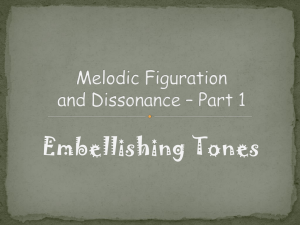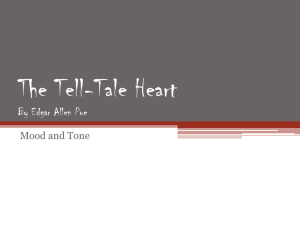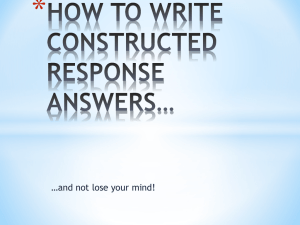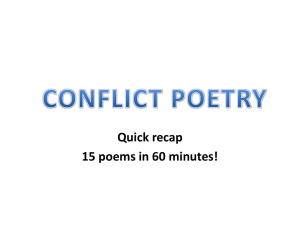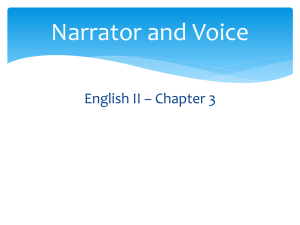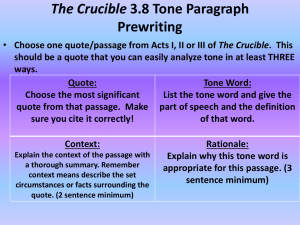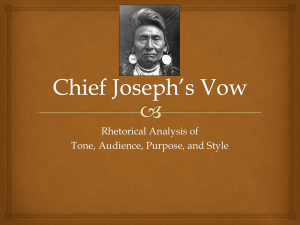AP Style Analysis Unit 1 Tone_Attitude
advertisement
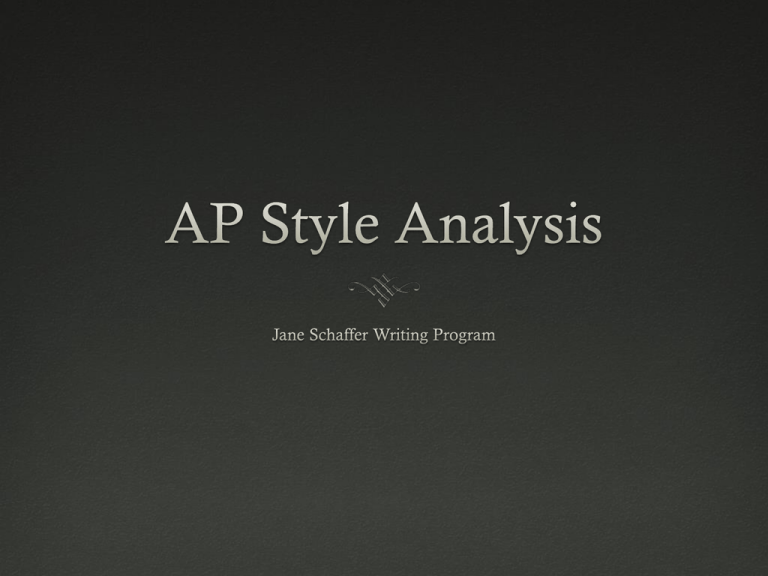
Overview of Unit You are starting a unit that will teach you how to analyze a writer’s style. There are 6 sections to study and 16 terms to memorize. These terms are sometimes called rhetorical, stylistic, or persuasive devices, techniques, or strategies. List of Style Terms Unit 1 1. 2. tone attitude Unit 2 3. 4. 5. 6. diction language figurative language figure of speech Unit 3 7. 8. detail imagery Unit 4 9. point of view 10. perspective Unit 5 11. organization 12. narrative structure 13. form Unit 6 14. syntax 15. sentence structure 16. phrasing To help you remember them, you will use a mnemonic device—a memory tool—that will give you a sentence to memorize. The first letter of each word in the sentence is also the first letter of one of the 16 terms. Tolling alone during lunch, Fred frantically decorated indigo plates perched on north-facing, slippery sheer pinnacles. Notice that the sentence maintains the order of the terms in the list. To help you remember it, copy it three times on a sheet of paper. Your next job is to draw a picture of the sentence on the back of your paper. The picture should include a drawing of Fred and what he is doing. Then practice reciting the terms out loud. You will have a quiz on them tomorrow. Take a look at the essay schematics. You have a chart, a sequential list, and a prose layout. You will choose which one you prefer to use. All style analysis essays have an introduction that names two different but complementary tones or attitudes and a conclusion that adds final thoughts on the paper. The number of body paragraphs depends on the number of techniques that you are analyzing. If you are not given any other directions you should have three body paragraphs---one for diction, one for detail, and one for organization. You will learn point of view and syntax analysis but you should avoid these unless you are told to analyze them. Point of view is fairly static (such as first person or third person) and syntax is the most difficult to master. Paragraph by technique rather than concept. You are learning how to do a timed writing. By having a technique oriented format to follow, you can move quickly through the essay and produce an organized and thoughtful analysis. Thesis and topic sentence are universally used in essays; other terms, however, are not. You will see the phrase concrete detail to mean either quotations, paraphrases or summaries. Commentary will be used to mean analysis or interpretation; and the word chunk will describe a 3-sentence unit of thought that incorporates one concrete detail and two commentary sentences. You will see all these terms in each schematic. You must become adept at recognizing tone and attitude in your reading. Tone describes the feelings in a passage; attitude describes the author’s or reader’s feelings toward the subject. For example, a statement like “The toddler grabbed the toy from his playmate and ran from the room as soon as his mother turned her back” conveys a defiant tone, but the author’s attitude could be described as disapproving. Complete the following activities for tone and attitude: 1. What does the word tone mean? (Define in your own words, look it up in the dictionary, or ask a classmate.) Write your definition in your notes. 2. What does the phrase tone of voice mean? (You should be able to define this on your own.) Write your definition in your notes. 3. List 5 words that could describe a person’s tone of voice. Example: angry Create a master list of everyone’s words. Everyone copies it. 4. Authors convey feeling in writing the same way that people convey feeling through tone of voice. Writers, though, must rely only on the printed word and cannot use inflection, volume, or gestures to make their point. Here is an example of a sentence that conveys an arrogant tone: John surveyed his classmates, congratulating himself for snatching the highest grade without studying at all, unlike all the other dolts in the class. Without using the word arrogant in the sentence, the writer has conveyed an arrogant tone. The words surveyed, congratulating, himself, snatching, and dolts suggest this feeling. 5. Your next assignment is to choose one word from the tone/attitude list you created. (Do not choose one of the words on the arrogance category.) Write one sentence on any topic that conveys the tone you choose without naming the tone word itself. Write your word, then write your sentence. Highlight the word in your sentence. 6. Now write commentary (analysis and interpretation) for your sentence. What words did you include that convey the tone you want, and why did you pick these particular ones? Share with your partner. Answer the following questions that go with “The Rattler”. Be ready to discuss. 1. How does the man feel about what he does? 2. What impression does the snake give? 3. What tone words come to mind to describe the feelings in this piece? (Think of different but complementary tone words.) Categorize the “tone” words into two columns. 1st tone (dignity) •duty •obligation •inevitability •acceptance 2nd tone (compassion) •respect •reluctance •remorse •regret •admiration Here is a sample thesis based on ideas from the chart. In “The Rattler,” the tones of obligation and remorse reflect the man’s reluctance to kill the snake but his understanding of the necessity to do so. Notice the prompt is not copied in the thesis. AP readers do have the prompt repeated in the introduction anywhere. Also notice that the thesis comes first. You will want to do this for timed writing purposes on the exam. Also notice that nouns are used to identify the tones in this sample. This is not the only way to accomplish the task, though; you could also use adjectives to do the same thing, as in the following example: In “The Rattler,” the remorseful and duty-bound tones reflect the man’s reluctance to kill the snake but his understanding of the necessity to do so. Some students like to use an adjective-noun combination instead: In “The Rattler,” the man’s regretful triumph reflects his reluctance to kill the snake but his understanding of the necessity to do so. All three are acceptable; the choice of the sentence pattern is up to you. Here is how each one looks when we write them as sentence frames: #1 The ____________ and ____________ tones… (adjective) (adjective) #2 The tones of ___________ and __________ … (noun) (noun) #3 The _____________ _____________ … (adjective) (noun) After you complete the thesis, elaborate on it for one or two more sentences to finish the introduction. Depending on the passage, use either present or past tense. Make sure you stick to the verb tense throughout your essay that you chose for your for your thesis. (1) In “The Rattler,” the tones of obligation and remorse reflect the man’s reluctance to kill the snake but his understanding of the necessity to do so. (2) Despite his guarded admiration for an opponent and his personal code of honor toward nature, he remains detached from his desire to see the snake go free. (3) He acknowledges his duty to others on the ranch but achieves, at best, a regretful triumph with the snake’s demise. After reading the Fredrick Douglass passage, discuss and answer the following questions: The author is Fredrick Douglas, a black writer born a slave in Maryland in 1817 who escaped to the North in 1838. How does he feel about his experiences? What tone words come to mind to describe this piece? (Think of different but complementary tone words.) Now fill in the chart below, categorizing the class’ tone words into two groups: 1st tone 2nd tone Now fill in the blanks in the following sentence. You will choose 2 different but complementary tones for blanks #1 and #2 and then fill in blank #3 with commentary to complete the thought. The (#1) ___________________ and (#2) ____________________tones in Douglas’ passage reflect his ________ _________________________________ _________________________________ _________________________________ Now add one or two sentences to your introduction— remember that the thesis above is sentence #1. After I check your work, copy your introduction for your final copy: Do NOT use quotations from the passage in your introduction. It will often sidetrack you and lead to a paragraph full of quotes but short on analysis.


